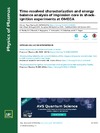Please use this identifier to cite or link to this item:
https://accedacris.ulpgc.es/handle/10553/47989
| Title: | Time-resolved characterization and energy balance analysis of implosion core in shock-ignition experiments at OMEGA | Authors: | Florido, R. Mancini, R. C. Nagayama, T. Tommasini, R. Delettrez, J. A. Regan, S. P. |
UNESCO Clasification: | 220410 Física de plasmas | Keywords: | Thermodynamic states and processes | Issue Date: | 2014 | Publisher: | 1070-664X | Project: | Determinación de Propiedades Radiativas, Termodinamicas y Diagnosis Espectroscopica de Plasmas de Interés Científico-Tecnológico | Journal: | Physics of Plasmas | Abstract: | Time-resolved temperature and density conditions in the core of shock-ignition implosions have been determined for the first time. The diagnostic method relies on the observation, with a streaked crystal spectrometer, of the signature of an Ar tracer added to the deuterium gas fill. The data analysis confirms the importance of the shell attenuation effect previously noted on time-integrated spectroscopic measurements of thick-wall targets [R. Florido et al., Phys. Rev. E 83, 066408 (2011)]. This effect must be taken into account in order to obtain reliable results. The extracted temperature and density time-histories are representative of the state of the core during the implosion deceleration and burning phases. As a consequence of the ignitor shock launched by the sharp intensity spike at the end of the laser pulse, observed average core electron temperature and mass density reach T 1100 eV and q 2 g/cm3 ; then temperature drops to T 920 eV while density rises to q 3.4 g/cm3 about the time of peak compression. Compared to 1D hydrodynamic simulations, the experiment shows similar maximum temperatures and smaller densities. Simulations do not reproduce all observations. Differences are noted in the heating dynamics driven by the ignitor shock and the optical depth time-history of the compressed shell. Time-histories of core conditions extracted from spectroscopy show that the implosion can be interpreted as a two-stage polytropic process. Furthermore, an energy balance analysis of implosion core suggests an increase in total energy greater than what 1D hydrodynamic simulations predict. This new methodology can be implemented in other ICF experiments to look into implosion dynamics and help to understand the underlying physics. | URI: | https://accedacris.ulpgc.es/handle/10553/47989 | ISSN: | 1070-664X | DOI: | 10.1063/1.4898329 | Source: | Physics Of Plasmas [ISSN 1070-664X], v. 21 (10) |
| Appears in Collections: | Artículos |
SCOPUSTM
Citations
12
checked on Jun 8, 2025
WEB OF SCIENCETM
Citations
11
checked on Jun 8, 2025
Page view(s)
100
checked on Oct 31, 2024
Download(s)
187
checked on Oct 31, 2024
Google ScholarTM
Check
Altmetric
Share
Export metadata
Items in accedaCRIS are protected by copyright, with all rights reserved, unless otherwise indicated.
